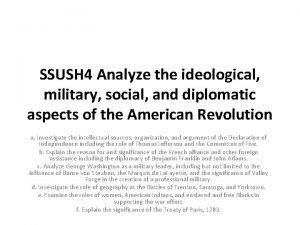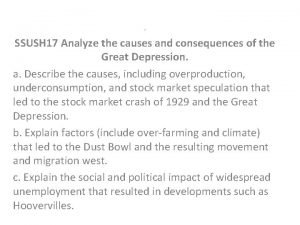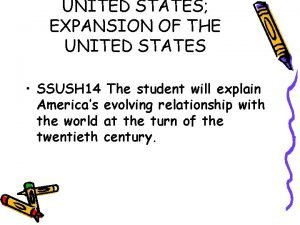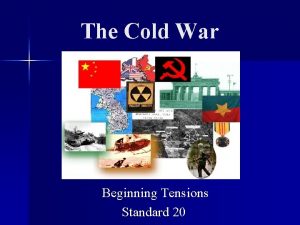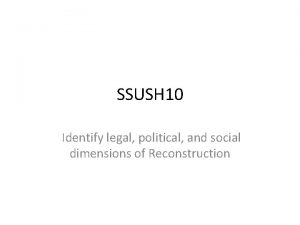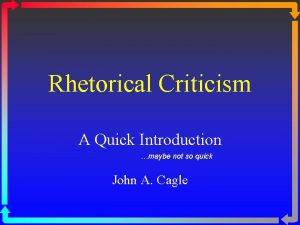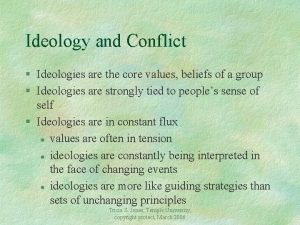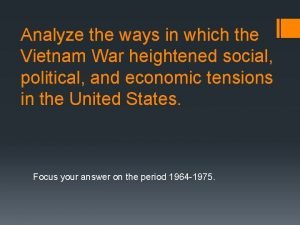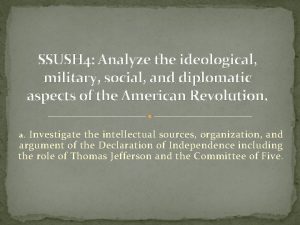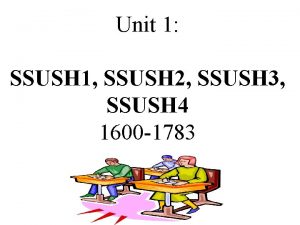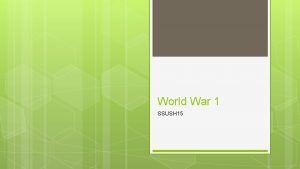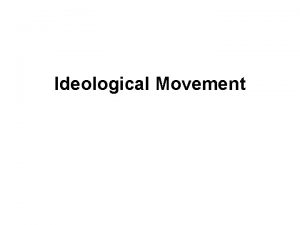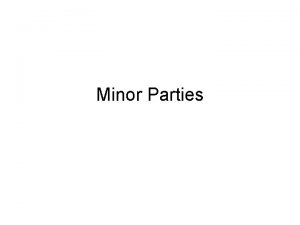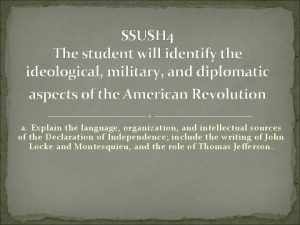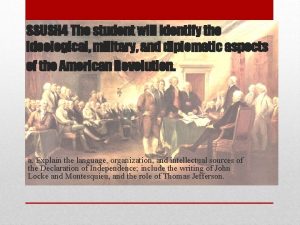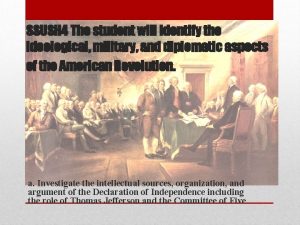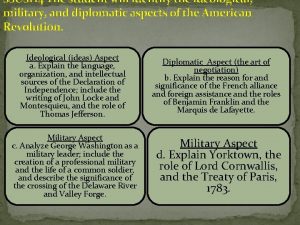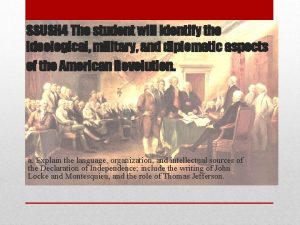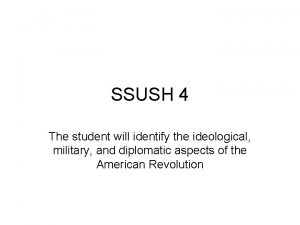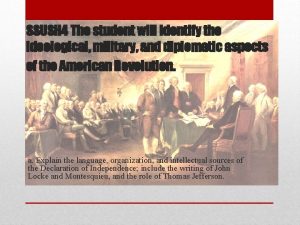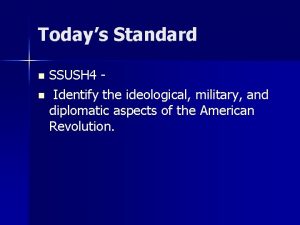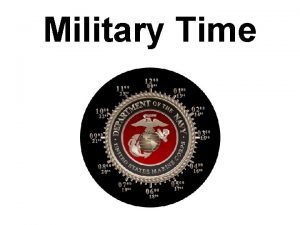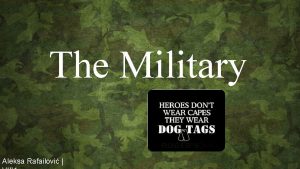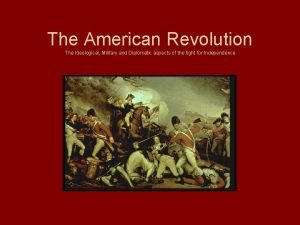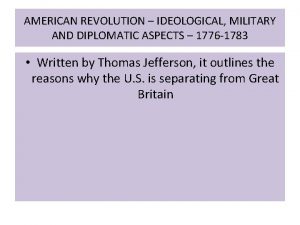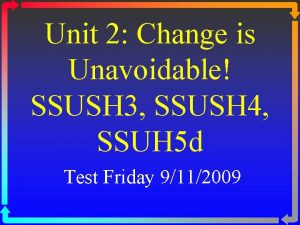SSUSH 4 Analyze the ideological military social and
































- Slides: 32

SSUSH 4 Analyze the ideological, military, social, and diplomatic aspects of the American Revolution a. Investigate the intellectual sources, organization, and argument of the Declaration of Independence including the role of Thomas Jefferson and the Committee of Five. b. Explain the reason for and significance of the French alliance and other foreign assistance including the diplomacy of Benjamin Franklin and John Adams. c. Analyze George Washington as a military leader, including but not limited to the influence of Baron von Steuben, the Marquis de La. Fayette, and the significance of Valley Forge in the creation of a professional military. d. Investigate the role of geography at the Battles of Trenton, Saratoga, and Yorktown. e. Examine the roles of women, American Indians, and enslaved and free Blacks in supporting the war effort. f. Explain the significance of the Treaty of Paris, 1783.

4. a- Investigate the intellectual sources, organization, and argument of the Declaration of Independence including the role of Thomas Jefferson and the Committee of Five . • The committee chosen by the Continental Congress in 1776 to draft the Declaration of Independence was not selected at random- Thomas Jefferson (Virginia) had already proven himself to be one of the most able and eloquent writers among the members of Congress. John Adams (Massachusetts) had been one of the earliest and most vocal advocates for independence, and Benjamin Franklin was as sage and acute as ever. The other members of the Committee of Five, Roger Sherman and Robert Livingston, were also well respected members of the Congress. • Jefferson did most of the writing- with some editing and advice from the others. What he produced was a document that asserted the independence of the American colonies with what amounted to a direct statement to King George III. • Jefferson drew heavily from political philosophy of the day to make his argument for independence. He especially drew from the ideas of John Locke.

Thomas Jefferson

Jefferson, Franklin, and Adams

Presenting the Declaration to Congress

• • Intellectual Sources, Organization and Arguments of the Declaration of Independence The Declaration of Independence is comprised of four sections: 1) the Preamble, 2) a Declaration of Natural Rights, 3) List of Grievances, 4) Resolution of Independence The Preamble explains and introduces the basic reasons (and political philosophy) underlying the decision for declaring independence from Britain. The Declaration of Natural Rights expands on the political philosophy mentioned in the preamble. Both of these sections draw heavily from the Enlightenment-era political theories of John Locke- an English writer/philosopher of the late 17 th/early 18 th century. Locke’s Two Treatises on Government (1690) introduced ideas about the “natural” rights of man , which he considered to be life, liberty and property. Locke asserted that government’s primary purpose was to maintain these rights for the people being governed. Locke extended his ideas about Natural Rights to lay the foundation for a Social Contract theory of government. In its essence the idea of the Social Contract is that any government ultimately rules with the consent of the people being ruled. Government received its power from the people, who agreed to give up certain freedoms in exchange for the protection of government. The implication , following Locke’s logic, is that when a government fails to meet the needs of its people-the government gets overthrown- and the people have the right to overthrow tyrannical governments. Jefferson was also familiar with the writings of French philosophers, including Montesquieu and Jean Jacques Rousseau. Montesquieu’s 1748 work, The Spirit of Laws was a major influence on political thinkers of the day, and Rousseau extended many of Locke’s central ideas about the sources of political authority in his 1762 treatise entitled “The Social Contract. ” The List of Grievances portion of the Declaration is just that: an item-by-item account of how Jefferson (speaking for the Congress) feels King George the III has wronged the American colonies. The Resolution of Independence asserts that the colonies were free from all political ties and allegiance to the British Crown- and that they could do all the things (prosecute war, conclude peace, make alliances, conduct commerce) that free and independent states do.

John Locke

4. b- Explain the reason for and significance of the French alliance and other foreign assistance including the diplomacy of Benjamin Franklin and John Adams. . • Once the Declaration had been issued, one of the primary objectives of the Congress was to secure diplomatic recognition from other nations- most importantly, France. • France had been secretly aiding the American military effort early on, but they were unwilling at first to risk war with Britain by formally recognizing, aiding, and allying with the United States. • The Continental Congress sent Benjamin Franklin, who was later joined for a time by John Adams, to the Court of Louis XVI to work at diplomatic recognition and direct military aid. The major turning point for the French followed news of the American victory at Saratoga, NY. Only when the French saw that the Americans had a chance to defeat the British were they willing to formally enter the war. • In February 1778 the United States negotiated its first two treaties with France- one extending formal recognition to the U. S. , and one offering direct military aid with land sea forces. The French contributions to the war effort gave the Americans the staying power they needed to wear the British down and eventually win the conflict.

Franklin in France- ca. 1778

Franklin at the French Court

c. Analyze George Washington as a military leader, including but not limited to the influence of Baron von Steuben, the Marquis de La. Fayette, and the significance of Valley Forge in the creation of a professional military. • • • George Washington’s reputation for even-headed leadership and daring military tactics had been established early in his career- in the opening battles of the French and Indian War. Washington was an obvious choice to lead the Continental Army and the Second Continental Congress gave him command in June 1775, following the creation of the Army following Lexington and Concord. The Continental Army at that time was a rag-tag collection of colonial militias that would require substantial training to be an effective and coherent force. And despite inducing the British to evacuate Boston, Washington and his Continentals lost several key battles early in the war- including New York City which then became the British headquarters throughout the war. When the British forces turned toward Philadelphia in late 1776, Washington led his Army to intercept them. As winter set in, Washington again proved his daring by crossing the icy Delaware River on December 25, attacking the encamped Hessian forces at Trenton, then scattering British regiments at Princeton. These victories, although small, were important to boost morale and established George Washington as a hero to then-struggling Revolution. In the winter of 1777, Washington and the Continental Army established quarters at Valley Forge, NJ. This was the darkest hour for the army. Nearly 2500 men froze or starved to death- although morale was boosted somewhat by training from some European generals, including Lafayette, and a German (Prussian) Baron, Friedrich von Steuben.

George Washington as a military leader • Clearly, Washington’s steady leadership and generally sound military tactics were very important contributions to the eventual victory over the British. • As mentioned, Washington struck at the British with daring when he could, and although he lost some important battles, he was always able to make strategic retreats and keep his army intact.

Baron von Steuben • • • Baron von Steuben, was a Prussian and American military officer. He served as inspector general and major general of the Continental Army during the American Revolutionary War. He is credited with being one of the fathers of the Continental Army in teaching them the essentials of military drills, tactics, and disciplines. He wrote Regulations for the Order and Discipline of the Troops of the United States, the book that served as standard United States drill manual until the American Civil War. He served as General George Washington's chief of staff in the final years of the war.

Marquis de Lafayette • The Marquis de Lafayette was a young French nobleman when he came to America to offer his services to the Continental Army. He helped to train soldiers and later commanded American and French forces in numerous battles. • His impassioned support for the American cause won him the admiration of the people as a hero of the Revolution. • He developed a close military and personal relationship with George Washington, serving as his aidede-camp for much of the war.

Lafayette and von Steuben • These experienced European military officers played a very important role in helping to turn the Continental Army into a much more disciplined and coherent fighting force.



George Washington

Washington reviewing troops at Valley Forge

Continental Soldier • • By comparison to the British, the Continental Army had far less experience, men and supplies. Paying for soldiers’ wages and materiel was also a problem because the Congress had no power to tax the individual states to help pay for the war. Much of the war was paid through foreign and private loans. Desertion and turnover was also a big problem for the Continentals. 230, 000 men served in the Army through the Revolution, but rarely more than 20, 000 at any one time. Many soldiers deserted their posts at planting and harvest time. Local militias also contributed to the American war effort, especially in the backcountry. These militias had even less training than the Continentals, but were often successful using guerilla tactics to harass and delay supply lines to the British regiments in the field. The life of a Continental soldier was grim: plagued by chronic lack of supplies, exposure to the elements, high desertion rates, and facing one of the best trained and equipped armies in the world

d. Investigate the role of geography at the Battles of Trenton, Saratoga, and Yorktown.

Battle of Trenton • The Battle of Trenton, and subsequent engagement at Princeton were the result of Washington’s daring crossing of the icy Delaware River in late December 1776. As mentioned, this surprise attack indicated Washington’s ability to strike at the British, and although a small victory, greatly helped to boost the sagging morale of Continental troops. Following the engagement, Washington retreated back across the Delaware and established his winter camp at Valley Forge, PA.

Battel of Saratoga • The Battle of Saratoga was fought in upstate New York in 1777. The importance of Saratoga is two-fold. It was the first major battle won by the Americans and it was this victory that helped to convince the French to offer formal financial and military assistance to the Americans. • From a geographic perspective, it was also of crucial importance to the Continental army because it prevented the British in Canada from joining with the British forces headquartered in New York City. Had these British armies been able to link, they would have cut off New England from the rest of America and the Continental Army would have faced a much more difficult task. Stopping the British Canadian forces at Saratoga was one of the most important turning points in the war for these reasons.

Battle of Yorktown • Although the British had captured Savannah, Charlestown and Wilmington earlier in the war, much of the interior of the South remained out of British control. The leader of the British forces, Lord Cornwallis decided to invade Virginia to cut off the South entirely. • Much of Virginia fell without a struggle, but when a large American force led by Anthony Wayne arrived in Virginia, Cornwallis was forced to retreat to the coast to maintain his supply lines from the sea. • In the meantime, Washington and the Continentals were joined by 6000 French reinforcements. Washington initially intended to re-take New York with this force, but upon hearing from French allies that French ships were en route from the Caribbean, he marched to Virginia instead. • With the French fleet blocking British re-supply at sea, Washington joined the American forces already in Virginia to block Cornwallis’ retreat by land. Cornwallis had no choice but to accept defeat, and surrender his army of 8000 to Washington at Yorktown, in October of 1781.


Lord Cornwallis • Cornwallis was the general of the British forces when they were forced to surrender at Yorktown, in October 1781.

e. Examine the roles of women, American Indians, and enslaved and free Blacks in supporting the war effort. • An often overlooked aspect of the Revolutionary War is the roles of women, American Indians and African-Americans (both enslaved and free). • Although there are examples of women participating in military roles, including a few spies and a handful that pretended to be men to enlist and serve, most Patriot women supported the cause in more traditional ways. • There were a substantial number of women, so-called “camp-followers, ” who served as nurses and cooks in Patriot encampments. Patriot women also supported the cause through fundraising efforts, or by making and donating supplies like food, uniforms and blankets. Women also made contributions in less obvious ways as they managed the farms and business affairs of husbands and fathers that had gone to war.

e. Examine the roles of women, American Indians, and enslaved and free Blacks in supporting the war effort. • American Indians also figured into the Revolutionary War in ways that are often neglected by history. • There was no broad consistency in which side American Indians chose to support. Some groups chose to fight alongside their American Patriot neighbors. For example Indians near Stockbridge, Massachusetts were among the first to join Patriot militias in New England. • Others supported the British because they thought they would do more to protect from encroachment on Indian lands in the long run, as they had attempted to do with the Proclamation of 1763, following The French and Indian War. The Cherokee, embittered after years of having their lands taken by westward migrating Americans in the Southern interior, lashed out by attacking American settlements with British support. • Still other groups were split in their support. Some tribes in the Iroquois Confederacy sided with the British while other of their kinsmen supported the Americans. The common denominator for the Indians as a whole was self-interest.

e. Examine the roles of women, American Indians, and enslaved and free Blacks in supporting the war effort. • Both free and enslaved African Americans also made contributions to the war effort on both sides. Free Blacks in New England were among the original core of the Continental Army that formed there following the start of the conflict, and freemen from across America served in state militias and volunteer regiments throughout the conflict. • Slaves figured into the wartime calculus of both sides as well. Virginia’s loyalist governor offered freedom to slaves who would escape to join the British ranks. And although southern Patriots were extremely reluctant to arm slaves for their cause, a few northern states, such as Rhode Island, offered to pay for the freedom of slaves whose owners would allow them to join the Patriot regiments forming there.

f. Explain the significance of the Treaty of Paris, 1783. • Following the surrender at Yorktown in 1781, the major fighting was finished and the Americans and British concluded a peace in 1783. This Treaty of Paris, also known as the “Peace of Paris” formally concluded the conflict by recognizing the sovereignty of the United States and delineating its borders. • The British retained Canada, but acquiesced to American demands to extend their western border to the Mississippi River. A separate treaty returned Florida to the Spanish.

1783 Treaty of Paris • The agreement that formally ended the conflict between Great Britain and its former colonies, now officially recognized as the United States of America. John Adams, Benjamin Franklin, and John Jay negotiated on behalf of the U. S. • Other terms included the return of Florida to the Spanish, and the return of several former French colonies in the Caribbean taken after the French and Indian War (Seven Years’ War).

 Ssush4 analyze the ideological military
Ssush4 analyze the ideological military Ssush
Ssush Ssush
Ssush Ssush
Ssush Ssush
Ssush Ssush
Ssush Ssush
Ssush Ssush
Ssush Cultural and ideological turns
Cultural and ideological turns Ideological criticism
Ideological criticism Define ideological parties
Define ideological parties Ideological criticism
Ideological criticism Four cornered ideological grid
Four cornered ideological grid Polyhydramnios
Polyhydramnios Ideological conflict definition
Ideological conflict definition Ideological reasoning examples
Ideological reasoning examples Ideological reasoning examples
Ideological reasoning examples Analyze the ways in which the vietnam war heightened social
Analyze the ways in which the vietnam war heightened social Military social work in south africa
Military social work in south africa Social thinking adalah
Social thinking adalah Social thinking social influence social relations
Social thinking social influence social relations Hình ảnh bộ gõ cơ thể búng tay
Hình ảnh bộ gõ cơ thể búng tay Frameset trong html5
Frameset trong html5 Bổ thể
Bổ thể Tỉ lệ cơ thể trẻ em
Tỉ lệ cơ thể trẻ em Gấu đi như thế nào
Gấu đi như thế nào Tư thế worms-breton
Tư thế worms-breton Chúa yêu trần thế alleluia
Chúa yêu trần thế alleluia Kể tên các môn thể thao
Kể tên các môn thể thao Thế nào là hệ số cao nhất
Thế nào là hệ số cao nhất Các châu lục và đại dương trên thế giới
Các châu lục và đại dương trên thế giới Công thức tính thế năng
Công thức tính thế năng Trời xanh đây là của chúng ta thể thơ
Trời xanh đây là của chúng ta thể thơ
